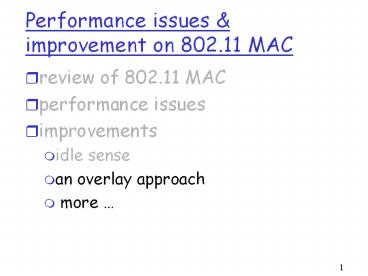Performance issues - PowerPoint PPT Presentation
1 / 25
Title:
Performance issues
Description:
Detour: strict priority scheduling. transmit highest priority queued packet ... Detour: weighted fair queuing. each class gets weighted amount of service in each cycle ... – PowerPoint PPT presentation
Number of Views:30
Avg rating:3.0/5.0
Title: Performance issues
1
Performance issues improvement on 802.11 MAC
- review of 802.11 MAC
- performance issues
- improvements
- idle sense
- an overlay approach
- more
2
An Overlay MAC Layer for 802.11 Networks
- Ananth Rao Ion Stoica
- UC Berkeley
- Mobisys 2005
3
Motivation
- 802.11 hardware provides initial ease of
deployability for many applications - mesh networks
- long haul links
- large Infrastructure Networks
- these apps stretching 802.11 beyond its design
goals (Wireless LANs)
Internet Gateway
4
Problem 1 different data rates
Data Rate Throughput
Case I A 11 Mbps 3.09 Mbps
Case I B 11 Mbps 3.36 Mbps
Case II A 11 Mbps 0.76 Mbps
Case II B 1 Mbps 0.76 Mbps
R
B
A
5
Problem 2 unpredictability
2
1
3
4
5
6
Problem 3 forwarding on behalf of others
Forwarders get same share as others
Ethernet
1/2
1/6
1/6
1/6
This problem cannot be solved by local scheduling
or queue management algorithms like WFQ
7
Approaches
- workarounds in routing/transport layer
- easy to deploy
- cannot address some issues
- change/replace MAC
- new protocols, new standard
- more powerful, hard to deploy
- overlay MAC layer (OML)
- directly on top of 802.11 MAC
- no need to change hardware
- directly use interfaces exposed by 802.11 cards
8
Advantage of an overlay approach
- easy to deploy
- easy to modify
- implemented in software
- easy to modify for diverse requirements
- tighter integration between MAC and upper layers
- performance benefits
- utilize information from higher layers
9
Bigger picture overlay network
10
Bigger picture overlay network
Focus at the application level
11
Even bigger picture virtualization
- Virtualization of resources powerful abstraction
in systems engineering - computing examples virtual memory, virtual
devices - virtual machines e.g., java
- IBM VM os from 1960s/70s
- Networking examples
- connecting local heterogeneous networks
- IP over ATM
- overlay networks
- VPN
12
Overlay MAC Layer (OML) design goals
- efficient
- fair or differentiated allocation
- flexible and low cost
- avoid modifying MAC
13
Overlay MAC Layer (OML) what can it control?
- no control in upper layer
- cannot decide when getting a packet
- no control in MAC
- cannot decide when packet is actually sent
- can control only when to send packet to network
card - packet scheduling policy FIFO, strict priority
scheduling, weighted fair queuing
14
Detour strict priority scheduling
- transmit highest priority queued packet
- multiple classes, with different priorities
- class may depend on marking or other header info,
e.g. IP source/dest, port numbers, etc.. - real world example reservations versus walk-ins
arrivals
time
packet service
time
departures
15
Detour weighted fair queuing
- each class gets weighted amount of service in
each cycle - equal weight Round Robin scheduling
16
OWL main idea use TDMA-like schedule
- divide time into slots
- weighted slot allocation (WSA) allocate slots to
nodes according to weighted fair queuing policy - assigns a weight to each node
- allocate slots proportion to nodes weights -gt
weighted allocation - a slot is only assigned to one node in an
interference region -gt reduce packet loss
17
Questions
- clock synchronization?
- slot length?
- interference region?
- weighted slot allocation
- how to choose weight?
- decide a winner w/o communication?
18
Clock synchronization slot size
- loose time synchronization
- leader-based
- estimate one way delay
- slot size transmit 10 packets of maximum size
- larger than clock synchronization error
- larger than packet transmission time
- as small as possible
19
Interference region
- ideally node i applies WSA to all nodes that
interfere with i - how to determine who interfere with me?
- assume a node can interfere with all nodes within
k-hop distance - only an approximation, not accurate
- how to determine interference relationship is an
active research
20
Weighted Slot Allocation decide winner w/o
communication
- each node uses pseudo-random function to generate
a random number - Hi H(ni, t) 1/wi
- t time slot, wi weight of node ni
- can generate random number for all nodes in the
collision domain (e.g., 2-hop neighborhood) - the highest number wins
21
Evaluation methodology
- Simulation in Qualnet
- Implementation in Atheros Madwifi driver Click
router
22
Summary of results
- Overhead OML thruput comparable to native 802.11
- reduced contention and retransmissions
- Fairness Fairness index for OML network much
higher - a nodes weight flows passing thru it
- Limitations Impact of mobility Interference
from native 802.11 clients
23
Simulation results
- Similar throughput to 802.11
- Control overhead is small
24
Simulation results (cont.)
- Improved fairness over standard 802.11
25
Summary
- overlay approach
- coarse-grained scheduling on top of 802.11
- less contention
- provide flexibility of assigning priorities to
senders - enables experiment with new scheduling and
bandwidth management algorithms































